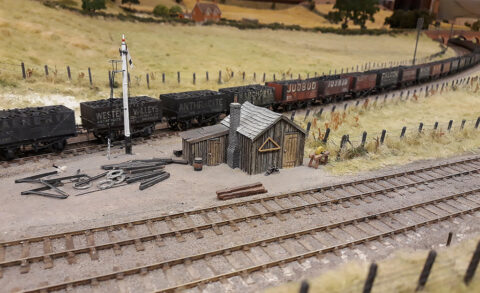In The Critic, Richard Bratby notes the solemn departure of the very last model railway train in Britain, at least based on recent reporting on the hobby:

“Platelayers hut and coal train” by Phil_Parker is licensed under CC BY 2.0 .
The last model train has departed, and in the attics and spare bedrooms of Britain, closure notices the size of thumbnails are being glued to cardboard stations. OO gauge track is being torn up; weeds made from lichen and flock shoot up where once there were busy miniature main lines. It’s Beeching all over again, just tiny. And in a desolate parade, once-cherished model locos trundle off to 4mm scale scrapyards, to stand lifeless and forgotten until, like their real-life forebears, they are broken up to be recycled as … oh, I don’t know. iPhones. Xboxes. Something modern, anyway. Something cool.
Well, I read it in the Telegraph, so it must be true. “Death of the Model Railway” proclaimed the headline last weekend, and the same story duly popped up all over the media, usually with some variant of “running out of steam”, or “going off the rails”. I was a bit late coming to the news because it was Saturday and I’d spent the afternoon building a model goods wagon from a plywood kit. I’d just added the lettering, and it came as a jolt to learn that the hobby no longer existed. Gingerly, I poked at the varnish I’d just applied — damn, still sticky, and now there was a socking great out-of-scale thumbprint spoiling the look of the thing. That seemed real enough.
But why did those headlines seem so familiar — and ring so false? True, 2024 has begun badly in the railway modelling world. Last week the organisers of the annual Warley National Model Railway Exhibition — a giant show held at the NEC in Birmingham, and a highlight of the hobby’s annual calendar — called it quits. A few days previously, the venerable model railway shop Hattons had announced that it was closing down after 78 years. Taken together, you can see why a journo from outside this particular subculture might link unrelated events into a bigger, juicier story. And let’s face it, a dig at railway enthusiasts is always good for a laugh, isn’t it?
I won’t deny that both events stung me. As a kid in the 80s I used to visit Hattons at its original Liverpool location. Even then, it felt old-school: a gloomy, musty terraced shop, piled to the ceiling with boxes and display cases. But a Saturday visit was like entering Aladdin’s cave and we’d always leave with some new treasure, wrapped in brown paper. Hattons has long since moved to newer, brighter premises and refocused on its mail-order business. I realise with a pang of shame that I’ve never used either.
As for the Warley Exhibition; well, I was there with my dad in November. It’s a regular father and son fixture a few weeks before Christmas, and if we’re honest we probably look forward to it rather more. It was rammed — 80-odd layouts (please, never “train sets”) from the UK, Europe and America, with crowds jostling four deep, and trade stands offering everything from antique clockwork models to the latest digital tech. My 12-year old eyes would have popped out of my head at the quantity and quality of products available. One stall was using airport-stye scanners to produce miniaturised replicas of its customers, so they could ride their model trains in person. If this is a hobby in decline, I’m not seeing it.
I’m going to stick my neck out here: correlation does not imply causation, and railway modelling is actually thriving. What the headlines describe is a collision of two familiar, but separate, 21st century trends the death of the high street, and the decline of old-style social clubs. Hattons never went bust: it read the runes and decided to get out in good order. As for Warley; well, if anything, the Exhibition seems to have been a victim of its own success. Like many leisure pursuits, railway modelling in the 20th century revolved around clubs, with all the paraphernalia of committees and tea rotas. People don’t do that quite so much nowadays.



